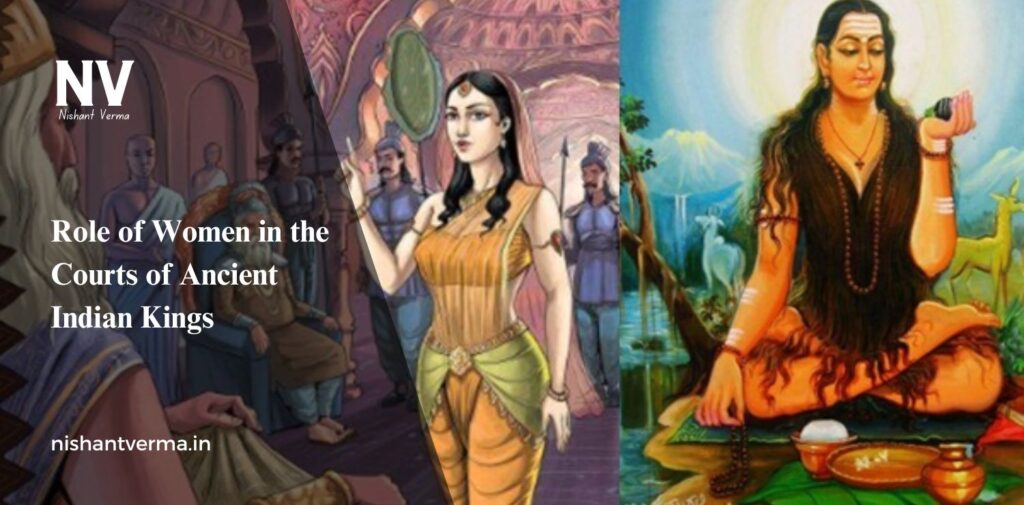In ancient India, the role of women in society and politics was complex and varied, especially in the courts. While the primary role of women was often seen as domestic, history reveals that women were not only central to the royal family but also played significant roles in the functioning of courts, politics, and culture. From queens and princesses to courtesans and scholars, women in ancient Indian courts were more than mere figures behind the scenes. They influenced decisions, participated in administration, and contributed to the cultural richness of their kingdoms.
The courts of ancient Indian kings were more than just administrative centers; they were hubs of culture, art, and political activity. These courts reflected the power, prestige, and wealth of the rulers, and women had an important presence in many aspects of court life. While their roles were influenced by the time period, region, and the type of monarchy in power, women in royal courts were integral to the social and political fabric of ancient India.
The Queen as a Political Figure
One of the most important roles that women held in ancient Indian courts was that of the queen. Queens were not just ceremonial figures; they played active roles in governance, diplomacy, and war. A queen’s influence often extended far beyond the household, especially if she was the mother of a king or heir.
For instance, Rani Durgavati of Gondwana in the 16th century is a striking example of a queen who wielded power. She defended her kingdom from invasions and played a crucial role in the political decisions of her time. Similarly, Rani Lakshmibai of Jhansi, although slightly later in history, became a symbol of resistance and leadership, particularly during the Indian Rebellion of 1857. Her courage and strategic insight made her an iconic figure, not just in the court but across the nation.
In the courts of earlier periods, such as during the Maurya or Gupta Dynasties, queens also had significant influence. For example, the Queen of Ashoka, Tishyaraksha, was said to have played an important role in her husband’s reign and helped guide some of his decisions, especially in matters concerning religion and diplomacy.

The Role of Royal Women in Diplomacy
Women in ancient Indian courts also played important roles in diplomacy and international relations. Marriages between royal families were often used to seal alliances between kingdoms, and many women in the courts were involved in these arrangements. These marriages helped ensure peace, trade, and political alliances between different regions of India and beyond.
For example, Prabhavati Gupta, the daughter of the Gupta Emperor Chandragupta II, was married into the Vakataka dynasty, a powerful family in present-day Maharashtra. Her marriage to the Vakataka king Rudrasena II strengthened ties between the two kingdoms and fostered political cooperation.
Additionally, royal women were often sent as ambassadors or envoys in foreign courts. Their presence in such roles reflected their high status and trustworthiness within their kingdoms. Women’s roles in diplomacy were not just about marriage but also involved direct political and cultural exchanges between states.

The Influence of Courtesans and Scholars
While queens and princesses were the primary political figures, other women in the courts were often influential through their intellect, skills, and talents. Courtesans, or women who were not married to the kings, were often highly educated and played important roles in the cultural life of the court.
These women were often skilled in the arts—music, dance, poetry, and literature—and were sought after for their knowledge and talents. Some of the most famous courtesans in history were known for their ability to influence the thinking and decisions of rulers and ministers.
For example, the renowned courtesan Amrapali, who lived during the time of the Buddha, is famous not just for her beauty but for her wisdom. She was well-versed in the arts and had an extraordinary ability to win the hearts of those around her. She later became a supporter of Buddhism and played an influential role in the history of the time.
Moreover, women were not just patrons of the arts; many were also artists themselves. Vidyavati, a prominent female scholar during the Gupta Empire, contributed to intellectual life through her writings and philosophy. Kalidasa, one of the greatest Sanskrit poets, is said to have had the patronage of women in royal courts, which allowed him to create some of his finest works.
The Role of Women in Religious and Cultural Life
In ancient Indian courts, women also played significant roles in the religious and cultural life of the kingdom. The royal courts were often centers of religious rituals, and women participated in these ceremonies either as leaders or as important figures. The wives of kings were frequently involved in religious practices, which were seen as a way to maintain the kingdom’s prosperity and stability.
Women also acted as patrons of religious institutions, building temples, commissioning sacred texts, and sponsoring religious festivals. The Chola dynasty of South India, for instance, saw the construction of temples like the Brihadeeswarar Temple in Tanjore, where women played a central role in the temple’s administration and religious functions.
Queen Rudrama Devi of the Kakatiya Dynasty (13th century) was a notable example of a woman who upheld both the political and cultural traditions of her kingdom. As a ruler, she contributed significantly to the flourishing of art, architecture, and religion, demonstrating that women could be powerful leaders in religious and cultural matters.

The Limitations Women Faced
Despite the significant roles women played in royal courts, they were not without limitations. Women in ancient India, particularly in the courts, were often expected to adhere to strict social norms. Their primary responsibilities were often tied to managing the household, securing alliances through marriage, and producing heirs.
Women’s involvement in the administration of the kingdom, though significant, was often behind the scenes. They were not always seen as direct rulers in their own right, although there were some exceptional women who broke these boundaries. Their influence, in many cases, was derived from their relationships with male rulers, either as queens, mothers, or consorts.
Additionally, the caste and societal systems of ancient India imposed certain restrictions on women’s freedom, particularly in terms of education and public life. While women in the royal family had better access to education, for many others, their lives were confined to domestic duties.
Conclusion – Role of Women in the Courts
The role of women in the courts of ancient Indian kings was far more significant than often depicted in conventional history. While their roles were often secondary to those of men, women in royal courts influenced politics, culture, religion, and diplomacy. Whether as queens, courtesans, scholars, or patrons of the arts, women played crucial roles in shaping the history and culture of ancient India.
Although many women operated within the constraints of their time, some managed to rise above societal expectations, becoming influential figures in their own right. Their contributions—be it in governance, diplomacy, intellectual pursuits, or cultural patronage—have had a lasting impact on the social and political development of ancient India. The legacy of these women continues to inspire and demonstrate that, even in the courts of ancient kings, women held power, influence, and respect.




